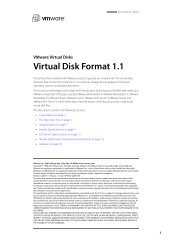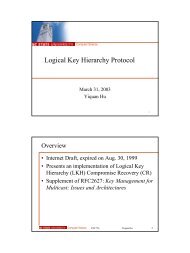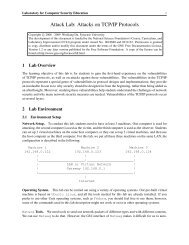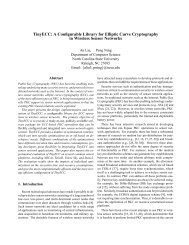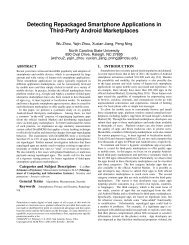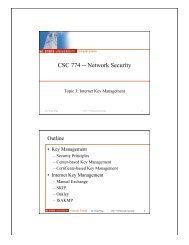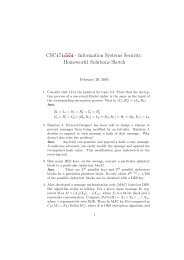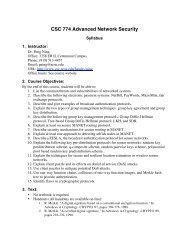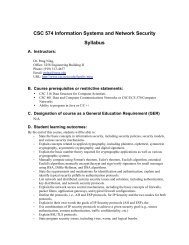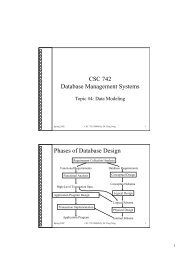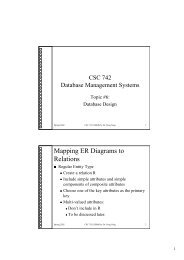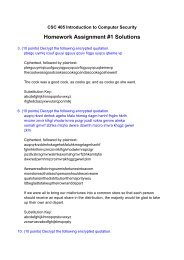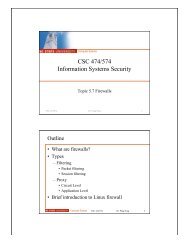A Flexible Approach to Intrusion Alert Anonymization and Correlation
A Flexible Approach to Intrusion Alert Anonymization and Correlation
A Flexible Approach to Intrusion Alert Anonymization and Correlation
Create successful ePaper yourself
Turn your PDF publications into a flip-book with our unique Google optimized e-Paper software.
nario specific data sets [14]. These data sets were collected<br />
in simulation networks <strong>and</strong> include two scenarios: LLDOS<br />
1.0 <strong>and</strong> LLDOS 2.0.2. Both scenarios have two data sets<br />
collected over different parts of the networks: the inside part<br />
<strong>and</strong> the DMZ part. In LLDOS 1.0, the attackers first probed<br />
the network, then launched buffer overflow attacks against<br />
vulnerable Sadmind services, next installed DDoS software<br />
on victim hosts, <strong>and</strong> finally ran DDoS attacks. LLDOS 2.0.2<br />
has a similar scenario as in LLDOS 1.0. We used RealSecure<br />
network sensor 6.0 <strong>to</strong> generate alerts from the data sets.<br />
Similar as done by DShield, we set attribute DestIP (destination<br />
IP addresses) in all alerts as sensitive attribute, <strong>and</strong><br />
anonymized them using the schemes in this paper.<br />
4.1. <strong>Alert</strong> <strong>Anonymization</strong> via Schemes I, II <strong>and</strong> III<br />
In our first set of experiments, our goal is <strong>to</strong> evaluate the<br />
effectiveness of artificial alert injection. We injected artificial<br />
alerts in<strong>to</strong> all four data sets based on Scheme I. We<br />
set the desirable general value for each DestIP <strong>to</strong> its corresponding<br />
/24 network address (L = 256). We used distance<br />
function D(f o , f m ) = ∑ x∈Dom(A s) |f m(x)−f o (x)|,<br />
<strong>and</strong> let distance threshold (between PMFs) be 0.3.<br />
In the second set of experiments, our goal is <strong>to</strong> see the<br />
effectiveness of attribute r<strong>and</strong>omization using Scheme II.<br />
We applied Scheme II <strong>to</strong> all four mixed data sets generated<br />
in the first set of experiments. Specifically, we r<strong>and</strong>omized<br />
each DestIP in mixed data sets <strong>to</strong> its 256-peer node (Any IP<br />
address in its /24 network).<br />
In the third set of experiments, our goal is <strong>to</strong> evaluate<br />
the effectiveness of Scheme III. we applied Scheme III <strong>to</strong><br />
all four mixed data sets. Specifically, we r<strong>and</strong>omized each<br />
DestIP in mixed data sets <strong>to</strong> its 256-peers. In addition, we<br />
set time interval I = 1 hour <strong>to</strong> partition data sets. Consequently,<br />
we got 4 subsets for LLDOS 1.0 Inside alert set,<br />
4 subsets for LLDOS 1.0 DMZ alert set, 2 subsets for LL-<br />
DOS 2.0.2 Inside alert set, <strong>and</strong> 2 subsets for LLDOS 2.0.2<br />
alert set.<br />
To see how our anonymization schemes may change the<br />
distributions of sensitive attributes <strong>and</strong> protect data privacy,<br />
we plotted the PMFs of attribute DestIP, <strong>and</strong> computed local<br />
<strong>and</strong> global privacy values for all three sets of experiments.<br />
Due <strong>to</strong> space constraint, we listed all PMFs of DestIP<br />
in Appendix B (in Figure 3). For local <strong>and</strong> global privacy<br />
values, we listed them in Table 1.<br />
Based on the PMFs in Figure 3, we observed that (1)<br />
Scheme I can change the distributions of DestIP compared<br />
with original data sets, (2) Scheme II may greatly<br />
change the distribution of DestIP in mixed alert sets, <strong>and</strong><br />
(3) Scheme III may further change DestIP distributes compared<br />
with the results in Scheme II.<br />
To precisely evaluate alert privacy, now let us look at local<br />
<strong>and</strong> global privacy values in Table 1. Based on this table,<br />
LLDOS 1.0 LLDOS 2.0.2<br />
Inside DMZ Inside DMZ<br />
Scheme I: R cc 100% 100% 100% 100%<br />
Scheme I: R mc 0.0305% 0.0649% 0.0418% 0.0736%<br />
Scheme II: R cc 100% 100% 100% 100%<br />
Scheme II: R mc 0% 0% 0% 0%<br />
Scheme III: R cc 100% 100% 100% 100%<br />
Scheme III: R mc 10.01% 8.27% 6.58% 4.32%<br />
Table 2. Similarity estimation<br />
we noticed that (1) through Scheme I, we can better protect<br />
alert privacy because both local <strong>and</strong> global privacy values<br />
increase. For example, in LLDOS 1.0 inside part, we injected<br />
around 15% of artificial alerts among all alerts, <strong>and</strong><br />
local privacy increases from 0 <strong>to</strong> 0.620, <strong>and</strong> global privacy<br />
increases from 4.696 <strong>to</strong> 5.692. (2) Through Scheme II, local<br />
privacy has significantly increased, which is highly desirable,<br />
<strong>and</strong> global privacy stays almost the same, which results<br />
from consistency keeping during r<strong>and</strong>omization. And<br />
(3) after applying Scheme III, local privacy stays the same,<br />
<strong>and</strong> global privacy further increases, which results from independent<br />
r<strong>and</strong>omization in each subset.<br />
4.2. Similarity Measurement<br />
In our experiments, similarity computation is based on<br />
our discussion on Subsection 3.1. For original data set,<br />
if two attribute values are the same, we set their similarity<br />
<strong>to</strong> 1; otherwise their similarity is 0. Next we applied<br />
three anonymization schemes independently, where<br />
we chose similar settings as in Subsection 4.1 (the only<br />
difference is that here we applied Schemes II <strong>and</strong> III <strong>to</strong><br />
original alert sets instead of mixed alert sets). For the data<br />
sets after applying Scheme I, we measured attribute similarity<br />
using the function for original sets. And for the<br />
data sets after applying Schemes II <strong>and</strong> III, we used the<br />
function in Subsection 3.1 <strong>to</strong> estimate their (lower-bound)<br />
similarity values. Next, similar as done in [29], we also<br />
used correct classification rate R cc <strong>and</strong> misclassification<br />
rate R mc <strong>to</strong> measure the effectiveness of similarity estimation.<br />
Given two attribute values, if their similarity value is<br />
greater than 0, we call them “similar” pair. Assume the<br />
alert sets before <strong>and</strong> after anonymization are S <strong>and</strong> S r ,<br />
# common similar pairs in S <strong>and</strong> Sr<br />
respectively, then R cc =<br />
# similar pairs in S<br />
, <strong>and</strong><br />
# similar pairs in Sr−# common similar pairs in S <strong>and</strong> Sr<br />
# <strong>to</strong>tal pairs−# similar pairs in S<br />
. The re-<br />
R mc =<br />
sults are shown in Table 2.<br />
From Table 2, we observed that the correct classification<br />
rate is 100%, <strong>and</strong> misclassification rate is low (the maximum<br />
is around 10%). We also notice that the results from<br />
Scheme II are very desirable. These results tell us that the<br />
data usability is still significantly preserved after performing<br />
our anonymization techniques.<br />
9



